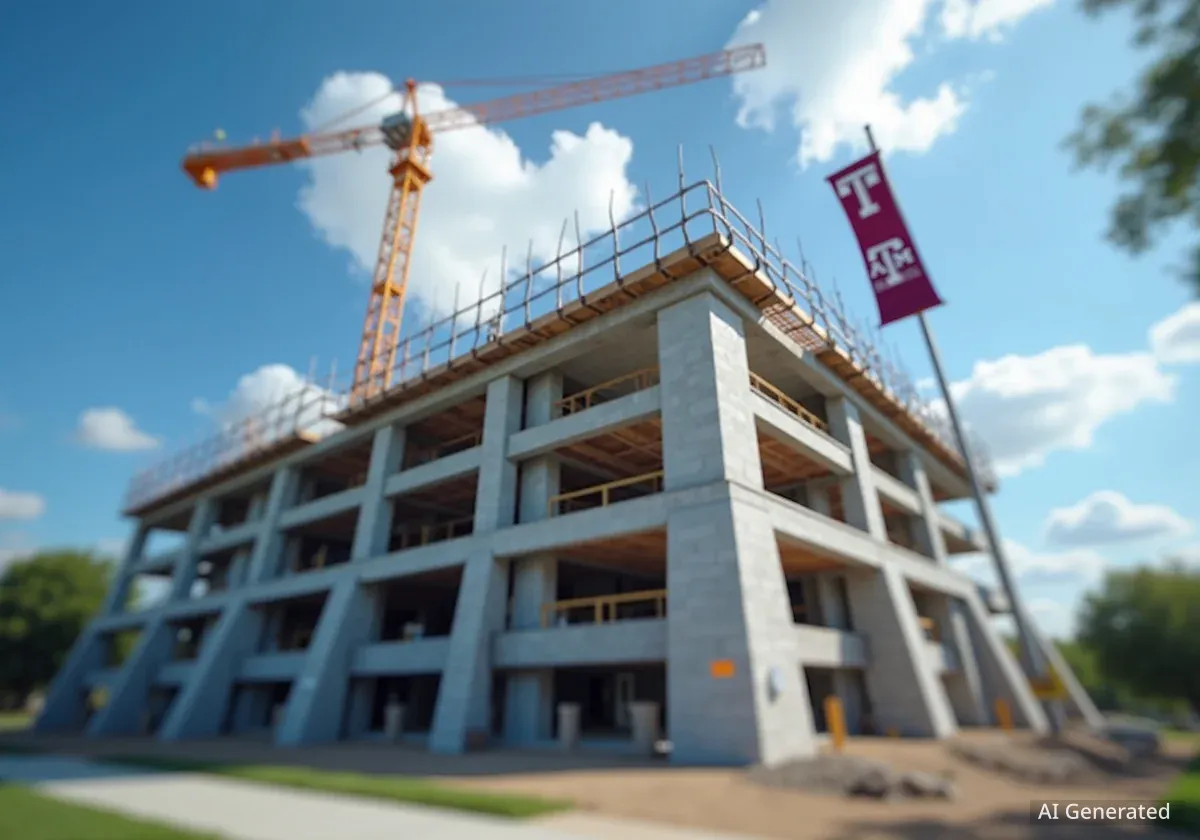Arch "Beaver" Aplin III, the founder of the popular Texas chain Buc-ee's, has made a significant financial contribution to Texas A&M University. This funding supports the creation of the Aplin Center, a new facility designed to enhance academic programs in hospitality, retail, food, and nutrition sciences. The center is expected to open in 2028 and will serve as a prominent gateway to the university campus.
Key Takeaways
- Buc-ee's founder Arch Aplin III donated a significant sum to Texas A&M.
- The Aplin Center will focus on hospitality, retail, food, and nutrition sciences.
- The 200,346-square-foot building is designed by DLR Group and Pickard Chilton.
- Construction begins this fall, with completion aimed for February 2028.
- The center will also include a Visitor Center and public event spaces.
New Center to Enhance Academic Programs
The Aplin Center will be a hub for students pursuing various fields related to hospitality and food industries. Arch Aplin, a 1980 graduate of Texas A&M with a degree in Construction Science, named the building after himself following his substantial donation. The facility aims to support coursework in diverse areas, from culinary arts to retail management.
According to Texas A&M, the center will be known as "Aggieland’s new front door." This highlights its role as a welcoming point for visitors and a symbol of the university's commitment to these growing academic disciplines. The project's total budget is $250 million, with Aplin's naming gift accounting for $50 million of this amount.
Aplin Center at a Glance
- Size: 200,346 square feet
- Stories: 3
- Structural System: Hybrid concrete and mass timber
- Estimated Opening: February 2028
- Total Project Budget: $250 million
Design and Architectural Features
The Aplin Center was designed through a collaboration between DLR Group and Pickard Chilton. The building will span 200,346 square feet across three stories. Its structure will combine concrete and mass timber, creating a modern yet robust aesthetic. Renderings show a design featuring three distinct wings: a long volume set back from the main road and two sections extending outwards.
The exterior will showcase extensive glass panels complemented by masonry cladding. On the ground level, the mass timber structure will be visible outside the glazing. Higher up, large windows will offer views into the interior, emphasizing the exposed wooden beams and panels. This design choice highlights the building's innovative use of sustainable materials.
What is Mass Timber?
Mass timber refers to a category of engineered wood products used in construction. It involves binding multiple layers of solid wood to create large, strong structural panels, beams, or columns. This method offers environmental benefits, including carbon sequestration, and can reduce construction time compared to traditional materials like concrete or steel.
The roof design incorporates gabled and inverted gable forms, which evoke traditional agricultural structures. Dormers will be integrated into the roofs, adding height and allowing more natural light into the building. The mass timber elements, primarily seen inside, will also be hinted at on the exterior through V-shaped columns that support the overhanging roofs. The three building volumes will sit on a large expanse of lawn, with pathways leading to the building and connecting to the surrounding campus and road.
"Our design for the Aplin Center puts education on display, blending hospitality-inspired public zones with focused academic spaces to foster spontaneous engagement and cross-disciplinary collaboration," said Stephanie Spingler, senior associate and interior designer at DLR Group.
Inside the Aplin Center: Academic and Public Spaces
The interior layout of the Aplin Center has been carefully planned to separate public-facing areas from academic spaces. Public zones, such as an experiential retail space and a culinary lab, will be located on the lower level. Lounges, lecture halls, and study areas will occupy the upper floors, providing dedicated spaces for learning and research.
The center will host a diverse range of academic programs. It will include teaching labs and research facilities for viticulture (grape cultivation) and enology (winemaking). There will also be hands-on classrooms for studying fermentation processes, coffee roasting, product development, food science, and hospitality management. The building will also feature a restaurant and a café, adding to its comprehensive offerings.
Supporting Campus Life and Visitors
Beyond its academic functions, the Aplin Center will serve as a significant welcoming point for guests visiting the Texas A&M campus. It will house a dedicated Visitor Center, a 170-seat theater, and a 70-seat multipurpose space. Staff offices will support these visitor services. This dual role underscores the center's importance both as an educational institution and a public gateway.
The integration of academic facilities with visitor services reflects a modern approach to university buildings. It allows the community to engage with the university's programs while providing essential resources for students and faculty. This comprehensive design aims to create a dynamic and inviting environment for all users.
Buc-ee's Expansion and Aplin's Philanthropy
Arch Aplin's donation to Texas A&M comes as his company, Buc-ee's, continues its rapid expansion across the United States. Originating in Texas, the chain has grown significantly, now operating 57 locations. These stores are found in states including Virginia, Tennessee, South Carolina, Missouri, Mississippi, Kentucky, Florida, Colorado, and Alabama.
Further expansion is planned, with new locations expected in Virginia, Ohio, Arkansas, Louisiana, Arizona, North Carolina, and Wisconsin. Buc-ee's is known for its large parking lots, clean restrooms, competitive wages for employees, extensive jerky options, and its beaver mascot. Industry analysts have estimated Buc-ee's top-line revenue to be between $2.5 billion and $5 billion. Aplin and his co-founder, Don Wasek, maintain 100 percent ownership of the company.
Aplin's gift ensures that future generations of Texas A&M students will benefit from state-of-the-art facilities. The university leadership has expressed excitement about the Aplin Center's potential impact. Robert Albritton, chairman of the school’s Board of Regents, commented,
"This one’s going to be as popular as Beaver Nuggets."This statement highlights the high expectations for the new center's success and popularity among the university community.
- 1982: Arch Aplin opens first Buc-ee's convenience store in Lake Jackson, Texas.
- 1980: Arch Aplin graduates from Texas A&M with a degree in Construction Science.
- 2025 (Fall): Construction on the Aplin Center is scheduled to begin.
- 2028 (February): Substantial completion of the Aplin Center is targeted.
The project represents a significant investment in educational infrastructure and a testament to the enduring connection between successful alumni and their alma maters. The Aplin Center is poised to become a landmark facility, enhancing both academic pursuits and campus visitor experiences at Texas A&M.




